Jo Gabriel
Tinderbox | The Unreachable Sky
album reviews and artist reflections
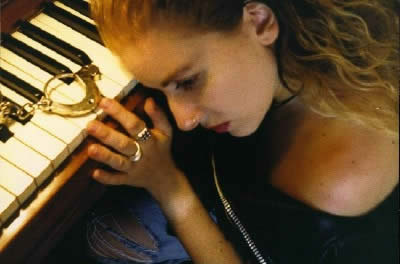
click on image to visit artists' website
reviews, interview and HTML © Russell W. Elliot 2003
all images © Faith Strange 1996-2003 | used with permission
Formatted for 800 x 600 or larger windows
Originally published: 04 August 2003 | Last updated: 05 June 2004
Jo Gabriel is an alternative singer songwriter whose passion for the craft is clear from two recordings recently released on the Faith Strange label. Entirely self-taught, her keyboard and vocal talents have drawn attention from major media critics and record labels. Likened by some to Kate Bush and Tori Amos, the artist draws natural influences from deep within her own musical psyche. Read our indepth interview with Jo, in two parts, below. The interview explores her background, discography and the sources of her inspiration. Our initial release of this article includes reviews of her two Faith Strange label releases Tinderbox and The Unreachable Sky. The article concludes with our 2004 review of her debut album Lying In The Evidence Of Love.
Interview
Musical Discoveries: Please would you tell us about your background.
Jo Gabriel: I donít know if you want me to go as far back as childhood, but I tend to be longwinded and itís probably a good idea to illustrate where I came from and the environment that served to inspire me.
That's great. Let's get into it.
I grew up in the suburbs of Long Island, New York. I began playing the piano at age eight. Prior to that, my parents had purchased one of those chord organs--with the letters and numbers on the keys--for my older brother. I was only five then but I wound up playing that dinosaur of an instrument all the time; making up these little melodies.
My parents decided that they should get me an acoustic piano instead. I played her constantly, creating these little musical exertions [excursions?]. I called them progressions. As I got older these progressions got more advanced. I did attempt to take lessons when I first started playing seriously but I found that I fought the structure and the formality of the whole experience. I definitely was developing the impression that I didnít want to be told what to play or to spend my time reciting someone elseís work. I wanted to create and perform my own music and I was maniacal about recording everything.
Tell us about some of your experiences.
I remember once I performed this 30-minute piece that I was so dilated from. But, when I had finished playing I realized that the tape deck didnít record the damn thing. I got up from the piano bench and quietly like Sisyphus, picked up the tape deck, walked outside and threw it onto my front lawn and sat back down at the piano again. It remained banished out there for quite some time that day.
What happened to those recordings?
I guess I was intense about my work even when I was very young. I have this large archive of musty old cassettes from those early years that I canít bring myself to discard, even though they are probably barely audible at this point. It would just seem like amputation to me if I lost these little remnants of my past.
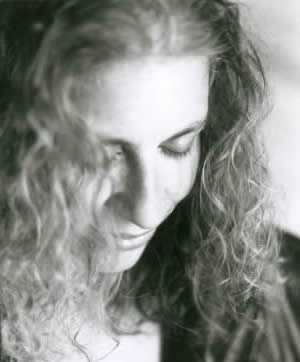 Image © Faith Strange Recordings 2003 |
Anyway, even though I rejected the training it was obvious to my schoolteachers and those around me that I had a musical aptitude, and they urged me with the promise of connections and very good written recommendations for me to attend Juilliard School of Music to become a concert pianist.
Still, I railed against the whole idea of structure and control. There are times when I do feel inhibited by the fact that I can't read music, but I never have a problem communicating my work to other musicians or arranging parts for various instruments.
Was there a lot of music in your house back then?
Growing up with a mother who had been a ballet dancer and was involved in regional theatre for many years definitely held sway over my dramatic induction. I remember waiting up late so often for her to come home from a production of William Enge's Bus Stop or Arthur Miller's The Crucible. I'd be entertaining myself with late night frights like Chiller Theater, Alfred Hitchcock Presents or Boris Karloff's Thriller.
My mother, at any given moment could also spontaneously burst into "The Impossible Dream" from Man of La Mancha and I would be awakening to a serenade of "Some Enchanted Evening" from Rodgers and Hammerstein's South Pacific. She still leaves phone messages like that now. So essentially some people got their motivation from Lee Strasberg or Uta Hagen, I got my training in the dramatic arts at home.
I also grew up surrounded by a diverse range of music. I listened vicariously to recordings from Puccini, Brahms, Liszt, Gershwin, to Anthony Newley's Stop the World I Want to Get Off. One of my brothers listened to The Birds, King Crimson, Jethro Tull, Iron Butterfly, Cat Stevens, and the other listened to The Bee Gees, The Beatles, and The Fifth Dimension. Needless to say, there was a lot of music being flung around my porous brain.
So how did all of this manifest itself in your work?
Beyond all the obvious stimuli from this atmosphere, I believe just as DaVinci spoke of a falcon touching down and brushing it's feathers in his mouth as being a divine interaction, that on some deeper level I was blessed with the gift of expressing myself through the greatest medium that is music. I am grateful that it manifested itself by way of my piano, or "caramacchioni"--in Italian it means "Dear Machine".
I started writing ballads in my early twenties and I came very close to selling a few. Barbara Weathers from Atlantic Star was about to go solo and wanted to use my song "I Need Your Love," but they dropped her contract in mid-flight. I have had many of these kinds of 'almosts' in my life. My ballads were really very good for that genre of music, but I started to get this empty ache in my gut that something was missing.
There is a line from the song "Give It Back" on Tinderbox that actually makes reference to this moment in my history when I literally fell to my knees one night, clenching both my fists and actually waving them at the ceiling, which was the closest view of the heavens and with wrenching appeals I asked, "who am I, what do I want to say." That night I wrote my first alternative piece of music. It rebelled against the pop music ballads I had written. I was reviving the old progressions with a new bent. I finally found my true voice, the inner as well as the outer.
I started to meet myself head on in the mirror of my music. My lyrics weren't about broken hearts and unrequited lovers anymore, at least not in the conventional sense.
The words were naked truths, exposures, criticisms, mysteries, revelations, resistance, transformations, and triumphs too. I wanted my work to be significant and actually effect people in that hidden place.
I finally managed to put yellow streamers around the ballads like a crime scene, and started work on the album Lying in the Evidence of Love. I worked with John Leitch at his studio, House of Ill Repute. We used to call it 'the little studio that could.' He was such an incredible guitarist.
The studio drummer who came in to do the session was a friend of John's Rich Pagano who was part of the band Mary Me Jane, featuring the great writing and lead vocals of Amanda Kravat. I used to call Rich's drum style his 'ghost beats.' When Lying was finished, we decided to start gigging out and showcasing in order to promote the album. That's when I met my current drummer, Linda Mackley, in the spring of 1995. We were definitely fated to be pals. She was so down to earth and versatile. We put the Jo Gabriel Band together and started playing out.
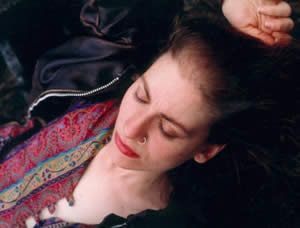 Image © Faith Strange Recordings 2003 |
What was that like?
We were very tight as musicians, very musical and very unique. I loved that my bass guitarist played fretless as it added such depth to the configuration. We were regulars at Brownies and CBís in NYC. We started to really make some noise in the industry. Many of the comments that would filter through were things like, "we don't know how to categorize her or where to place her in a specific format" so the suits didn't create a space for me.
Then, the upsurge of female artists hit the proverbial fan, and at that point, it seemed like I was coming in after the boat had already arrived, when in fact I was already doing alternative music in the scene for a while. First I was too original, and then I was a little fish in a very big pond.
And then what happened?
My album fell into the hands of renowned drummer Rod Morgenstein, who played with inimitable guitarist Steve Morse in the Dixie Dreggs. He was blown away and decided that with his contacts he could really hook me up in the industry. He arranged to have the suits come down to our shows. Andy Karp the A&R rep from Lava Records had seen us one night and decided that Lava would fund a studio session in hopes of potentially signing us. Jason Flom, the head of Lava, is actually the guy that finally signed Tori Amos to Atlantic Records. Jason said he thought I was an incredible songwriter but that they didnít want to have two similar artists on the label at that time.
So after many sessions at 6/8 Studios in NYC, Lava decided to pass. I respect Jason's decision but I was getting a little tired of the comparisons to Tori. We continued to gig and worked on a second album, Heavy Gray Line. We hooked up with Engineer/Producer Mark Mandelbaum and spent several months laying basic tracks and conceptualizing production ideas. Unfortunately, this album was a jewel on a train that was set to derail. Linda and I would love to resurrect some of those great songs and re-execute them down the road. It is unfortunate on so many levels that it never was completed.
Can you tell us a little more about it?
I had some wonderful musicians anxious to contribute their work on Heavy Gray Line. I recently ran into Lisa Gutkin awesome Celtic violinist, of Whirligig. She asked me what happened and that she was really looking forward to working on the project. I also had Jerry OíSullivan who was lined up to perform his Uillian pipes.
Albert Bonanno played upright bass on one of my favorite tracks "Objects In The Mirror are Closer than They Appear." My friend, Aprile Millo, world renowned mezzo soprano opera singer, was going to add some background vocals for me.
Well the band dissolved after that, there was a funeral pyre in memorial and essentially all communications broke down. After the smoke from the wreckage and debris cleared, Linda Mackley and I were the last women standing. We remained friends and musical collaborators. We witnessed many people falling away but we got closer and resolved to move on.
Where did the Tinderbox album come from?
I am very proud of the PBS documentary With One Voice: The Battle Against Breast Cancer on Long Island that I scored. It was a long process of marrying the right musical emotion to the images presented to me. I am so glad that I had the opportunity to contribute something of value to a very serious cause. Linda and I went on to perform the music video Passing Through Obscurity for a live television audience at Hofstra University in New York. This was a 30-minute show consisting of seven songs. This live performance is what eventually evolved into the album Tinderbox.
And how about The Unreachable Sky?
After Passing Through Obscurity I focused on another project, The Unreachable Sky that I initially recorded at my own Traveling Mothlight Theatre. This was a solo experiment where I remained isolated for a few weeks doing the Dr Pretorious mad scientist routine. I started corresponding with Mike Fazio again. We had met back in the days of my showcasing with the Jo Gabriel Band. Mike is a real kindred spirit. He has a very distinct approach to his guitar playing and a powerful grasp of music and his own vision. He supports and encourages me when I want to explore regions that would otherwise intimidate or bemuse other artists So that is sort of the landscape that led me here.
So how did you develop your vocal style?
This was a very organic flux that emerged quite overnight, for years. Composing for the piano and vocalization is a very simultaneous process for me so I am not very self-conscious about what I am doing when I am singing. It really serves more as an indicator of how the music is moving me. Initially it had more of a raw quality to it.
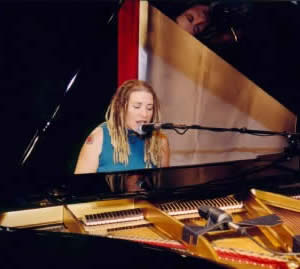 Image © Faith Strange Recordings 2003 |
I have had no vocal training. I just let it be. I am pretty pragmatic about it. Some things are instinctive and so you just allow them their ease of movement and the liberty to breathe. I feel the same way about my writing and the way I approach the piano. If I think the life out of something then it isn't natural anymore, it becomes a device.
Are there any artists that influenced you?
I think there will always be comfortable comparisons made in order to have an artist seem more accessible. I have had correlations made between myself and Joni Mitchell, Laura Nero, and Kate Bush. People have always drawn attention to the similarities. I will probably never escape the parallel. At least they are women that I ultimately worship and admire and if a match had to be made, I could not ask for a higher honor.
Back in 1986, John Leitch told me I sounded a lot like Kate Bush but I didnít really know much about her. I was already promoting Lying in the Evidence of Love when someone told me to check out Tori Amos. She was still kind of obscure back then, so I went out and got Little Earthquakes. I remember thinking, "oh my god this woman is amazing." Then she started to get a lot of exposure and the comparisons began breaking over my head like bottles of beer at a bar brawl. What can I say?
Rich Lupescu wrote a review of Lying in the Evidence in Modern Musician Monthly. He expressed his opinion that I was doing my music quite independent of any other influence and that he s uspected I was doing it long before Tori Amos had come onto the scene. I remember being so grateful for the acknowledgment that I actually called Rich to thank him. I almost sent him flowers! They were planning to do a cover feature article on me when the publication shut down; another almost lay at my feet.
How about musical influences?
My relatives were from the Ukraine and Istanbul, Turkey. My grandfather spoke of our relatives as being Bessarabian and Gypsy. I have a sense that these ancestral influences are in my blood. The Gypsies are a very musical mystical people who thrive on oral history and are vastly dramatic and colorful. Supposedly, my Aunt Edith had escaped Russia with the help of a Cossack who had fallen in love with her. How epic!
I believe my Aunt Edith was very psychic at least what you might consider highly intuitive. She used to read my cards. So perhaps my influences have been passed down from a long deceased relative from Kiev. Even my attraction to the mystical and the dramatic might be an infusion from a past ancestral life.
In fact, the song "Danse Papusza" on the Unreachable Sky is a tribute to Bronislawa Wajs. She was one of the greatest Gypsy singers and poets who lived her life in Poland, but when she died in 1987 nobody was there to honor her, because she had been excommunicated from the Polish Roma for inadvertently allowing her poems to be published. She lived alone and in isolation, shunned by her own generation and unknown to the next. She became mute and discarded. I felt this a great tragedy so I was compelled to write this piece in honor of her memory.
Have you listened much to Kate Bush, Tori Amos, Michelle Young and Rachael Sage?
I have been listening to Kate ever since I discovered her personally. A little while after John made the reference to Kate and I sounding alike, I had been watching VH1 and this video came on with the most intoxicating, other worldly, theatrical performer surrounded by this drum and fife corp. I had never experienced anything like it ever! It was "Running up that Hill" and I remember the tears crashing down my cheeks. It was one of my earliest Pomo Epiphanies. I was in the presence of greatness, and more than that there was the revelation that all my internal machinations had been exposed in full force. She gave me the truth. She validated my dream. She is the great storyteller. Kate reaches in on so many levels. I am always undone when I listen to her.
Sensual World and Hounds of Love are a masterpieces and although I might be in the minority on this one I think The Dreaming is one of her best works. I have actually been trying to find a way to contact Kate Bush so that I might send her my music, as I would love the gift of her feedback.
I used to listen to Tori a lot more when I wanted to experience the visceral reaction she would create in me, but I havenít visited with her in a very long time. I hadn't heard of Michelle Young until Musical Discoveries, but she sounds wonderful. (interview continued below)
Reviews
 Tinderbox | artwork Jo Gabriel Image © Faith Strange Recordings 2003 |
Tinderbox. A 30-minute, 7-track selection taken from Jo's music video Passing Through Obscurity, Jo's second album (Faith Strange (USA) FS3, 2003) is certain to delight enthusiasts of Rachael Sage, Michelle Young, Kate Bush and other alternative style singer songwriters. The music is backed by piano and drums and has been enhanced from the original DAT recording (see interview). Mike Fazio did an excellent job with the engineering work involved with the production. Jo is joined by Linda Mackley on drums and Mike Fazio on ebow guitar. Her sampling work is also heard on the recording.
The short intro "Nightdigging"--sung in language other than English--opens Tinderbox drawing the listener into the album with Jo's soaring vocals backed with edgy piano, warm keyboard washes and Linda Mackley's light percussion. Punchy piano is joined by lush orchestral keyboards and thicker percussion in the title track in which Jo sings louder and soars further above the instrumentals. We especially enjoyed the arrangement of the piece and Jo's dynamic piano playing. "Island" is a slower, more cinematic, piece whose drama is brought out with the richness of the keyboard washes that underscore the piano melodies and Jo's evocatively presented vocal section. Her soaring vocalise is incredibly delivered.
Like "Tinderbox," "Wash Away" is one of the album's standouts; Linda Mackley's drumming jumps out of the arrangement, working well with keyboard and piano. But it is the sensual delivery of the lyric by Jo Gabriel and the wonderful vocal harmonies set behind her that make the song work so well. Accompanied only by piano with a ligh keyboard wash as well Jo's vocals soar in "Give It Back." Further sampled vocalise in the background adds texture to the emotionally delivered lead. The style continues to develop in "Broken," a gentle ballad--and further album standout--with a tremendous chorus and alternatively styled instrumental bridge.
The album concludes with the sensually delivered track "Little Birds." Again piano and keyboard work
harmoniously with Jo's vocals and sampled harmony layers laid perfectly atop the instrumentals. An excellent
vocal oriented album, we wish only that the producers had included some bonus tracks to increase the running
time of the CD. There is some chance that the original video production recorded at Hofstra University in 2000
will be made available for enthusiasts in the future. 
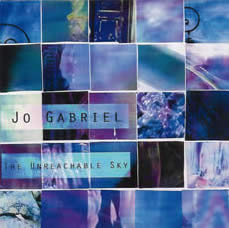 The Unreachable Sky | artwork Jo Gabriel Image © Faith Strange Recordings 2003 |
The Unreachable Sky. Jo's third album (Faith Strange Recording (USA) FS4, 2003) is, for the most part, an instrumental album. Comprised of 18 tracks, and recorded initially on Jo's Traveling Mothlight Theatre analog studio in 2000, the project was enhanced by Mike Fazio (see interview). The vocal sections are as marvelous as on Tinderbox, but they are fewer and farther between. Keyboard and piano work are edgy and perfectly support the soundtrack style texture of the album, in contrast to the singer/songwriter style of Tinderbox. The album runs for over an hour.
Variations on the "Tinderbox" theme return throughout the classically textured piano movements within the album. A "Waltz" and "Minuet" versions, for example have been laid down. The piano is joined with light keyboard washes to add orchestral textures. Jo's passionate attack of the piano is evident throughout. In addition to piano and keyboard, Jo contributes electric guitar to the work. John Lee guests with a superb violin part on "Mother May I," one of the album's strongest pieces. The violin compliments Jo's stunning lead vocal and provides a rich arrangement. Linda Mackley plays drums on "Movement." That Jo is neither classically trained on piano nor can she read music, especially when compared to the virtuousity displayed by her playing, simply defies belief.
We especially enjoyed the vocal selections from the album. Sung with Jo's characteristic
soaring soprano, these tracks -- "I'm OK," "Mother May I" and "7 Little Secrets" -- are just delightful. While the
team have done an excellent job in enhancing the original recording, the quality that appears on the CD does
not do the material the entire justice that it is due. A lot of cleanup was done to bring the recording to the
stage that appears on the CD but a fresh recording of the material with production that has a bit less reverb
would likely better show the strength of the songwriting and individual performances better. If "Tinderbox"
is a vocal album then surely "The Unreachable Sky" is an instrumental. 
Interview (continued)
Tell us more about the original recordings of the two albums.
Tinderbox was originally recorded live to DAT. The text on the CD includes an apology for the original recording. This was to deflect any blame from Mike Fazio and the end result. I was so immersed in the live performance of what was originally titled Passing Through Obscurity that I wasn't in a position to oversee the technical aspect of the recording process so I had no idea the needle was hemorrhaging in the red.
 Image © Faith Strange Recordings 2003 |
I had chosen songs that were particularly sacred to me. I also was very cognizant of the need to create a flow, and a specific sense of continuity for the music video. We only had the 30-minute window as it was a live television format. I recall the moment when Linda and I made it through the dark tunnel of anticipation and realized we had a final take.
The Unreachable Sky was a spontaneous exquisite manifestation. I worked completely alone initially. It was like one continuous dream or thought. I recorded on Mothlight Theatre, which is the name I gave my 4-track analog set up. I play a Kurzweil in addition to the acoustic piano. The performances were so organic but the sound quality left Mike Fazio with a big challenge.
I took a hiatus from gigging at this time and decided to focus exclusively on the restoration of Tinderbox and Sky and to remain in writing mode.
Where are copies of the debut album available?
Lying in The Evidence of Love had a very limited run. I believe that copies are still available from Harmony Ridge Music. I actually have been flirting with the idea of re-issuing it through Faith Strange. If there were enough of a desire for it that would probably give me the impetus to re-release it on a larger scale.
What was done to the original material to prepare Tinderbox for the Faith Strange releases?
Mike transferred the live DAT recording of piano/vocals/drums to hard disk via a Mac G4 to stereo. From there it went to Digital Performer and Waves Restoration to strip away what he could from the remnants of the noise from the original low quality recording. This was done painstakingly in six passes, stripping away buzz, clicks, pops, hum and digital clipping incurred from the live recording being recorded at too high a volume to DAT.
After Mike approached the sound files with a more surgical touch to extract any remaining artifacts with Bias Peak. These were then re-transferred to Digital Performer and layered upon with the other instruments that I performed as added texture. Finally, it was mixed and mastered using a smorgasbord of digital as well as analog hardware.
And The Unreachable Sky?
We approached it pretty much in the same manner, but using analog tapes from my Mothlight Studio as the starting points as opposed to DAT Tapes. The mixing process approached for Sky was a bit more experimental in that many digital plug-ins and effects were utilized to render the surreal dream like quality that Mike imbued onto the work.
A lot of it was a stream of consciousness approach done late at night. As Mike coins a phrase from Joe Meek one of his engineering heroes "if it sounded right, it was right." Mike did all of this work in seclusion, the approach that he has found works best for him based upon all his experiences.
Who are some of your favorite artists?
I keep remembering so many and I am afraid to omit someone that I truly admire. Of course Iíve already mentioned Kate Bush. Bjork is just magical, PJ Harvey evokes a runaway train heading towards "who the hell cares, let's just get on board and enjoy the ride."
Lisa Germano is a wonderful sideshow poet who reminisces through broken hearts and refracted dreams She makes her inner wounds seem lyrical. I relate to her a lot. Her intense thoughts and the promise of renewal by way of irony. She has a way of exposing her vulnerability without coming across weak or a like a victim. And her voice is absolutely exquisite.
I have such a diverse taste in the arts and music that it could become a Tolstoy novel, but it's hard to pick one and not add on and on and on. I like good songwriting.
Erik Satie, the Cocteau Twins, Sheila Chandra, Claudio Simonetti of the Goblins Vivaldi, Beethoven, Chopin, Edith Piaf, Renata Tibaldi, Sarmila Roy, the Bulgarian Womenís Choir, Hildegard Von Bingen, Deep Forest, Joni Mitchell Cat Stevens, the Indigo Girls, Heather Nova, Harold Budd, the Sundays, Rodgers and Hammerstein, Peter Gabriel, Lisa Gerrard, Dead Can Dance, Steven Sondheim, Jane Siberry, Marianne Faithfull, Annie Lenox, Minnie Ripperton, Angela Bofill, Lalo Schifrin, Aimee Mann, Otis Redding, Billy Holiday, Kurt Weill, Brian Eno, the October Project, Mark Eitzel, Sinead O'Conner, Michel Legrand, Youssou Nídor.
And the great film score crew. Jerry Goldsmith, Gil Melle, Dominic Frontiere, Mort Stevens, Ennio Morricone, Bernard Herrman, and Franz Waxman, Francis Lai.
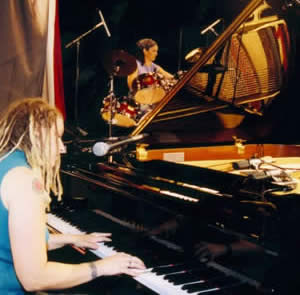 Image © Faith Strange Recordings 2003 |
Where do you draw your inspiration for the music?
Rubyat said, "I am myself; heaven and hell." I re-visit old paradigms in dark nights of the soul that get purged in self-awareness. Conjuring the ghosts in my heart flushed out by random surroundings or occurrences, like watching an old film that manifests a feeling of nostalgia.
Theordore Roethke had said, "What shakes the eye but the invisible." This is how I operate. I am very empirical on one hand, using all six senses. And yet I am often cerebral as well. The two forces fuse and then whisper their ideas to me. It's really very hard to explain the natural process of creating. When a plant leans in toward the light there is a basic scientific explanation assigned to this system of action. But, there are reasons beyond that, operating in the movement of all life.
I am not being religious here, but I am acknowledging the unknown, the unpredictable, the soul of nature. The meaning behind night and day is way more complicated than just the sun and moon. I draw my inspirations from the elementals of life. Things pushed in plain sight that are being set in motion by the unseen. I draw my inspiration from great literary characters, films that dwell in vast expanses of shadow.
Art that is intelligent as well as visceral, passionate, insurgent, beautiful and even disturbing or subjectively ugly. The ecstasy of a single simple blissful moment in time. There are so many triggers, abstractions that form random impressions.
How would you describe your music?
I don't consider myself a storyteller. I create a conduit between the heart and the head, but I don't relate a particular tale or narrative. I think my music evokes stories for people that are rather personal, but I don't try to tell anyone what to think when they listen to my work. Iíve been told that my voice is very ethereal.
I really try to be as genuine as I can when I approach my music. I think it translates that way. People can tell when you're full of shit. I really feel what I play and it seems to effect people. I think of my lyrics as if they were these poems that sing for themselves. I like to describe everything. Everything looks like something else or reminds me of something else. It's one grand metaphor. Even in my casual routine I wander into referential dialogue.
I love to manipulate words. Words are powerful as hell. I believe that my piano style is very unique. As far as categorizing my work in any specific genre. I really consider it Ambient and Gothic Ethereal and Modern Classical a nd Alternative.
What is the creative process like in the studio?
My best studio experience as far as being fulfilling, validating, exciting, absorbing, and experimental and the most creative license I have ever been afforded has been working at Mothlight by myself and then with Mike Fazio at his Luna County Observatory. When I recorded Amber Sessions and Last Drive-in I was completely isolated, and just as it happened with The Unreachable Sky, these two albums were very stream of consciousness and solitary in design and performances.
I would layer all these eclectic instruments and textures without a forecast or predication of what might emerge as the end result. I do start with certain impressions and I am drawn to particular tones, moods, and the attitudes of certain sounds. But, the overall process is without consciousness, it is surreal and fluid. That's how it all reveals itself to me. It's just channeled from the heavy undertow of the hidden.
I love to conjure sound. I manipulate sound by reversing the recording and then feeding it back into the system creating a loop of soundscapes. I get to tap into the nether regions of my imagination alone, and with Mike nothing is absurd or improbable when we work together on a project. I first explore my ideas that might otherwise intimidate and bemuse another artists and then he leads me to the solution of expressing it in every detail as the finished product. He knows his craft. Heís a very articulate and intelligent man.
We meet on a level that has been the easiest conceptual collaboration I have had with someone in a studio setting Mike has the most unique approach to his Ebow and Slide guitars. He creates a dream like quality that penetrates.
His recent orchestramaxfieldparrish release Tears is a masterpiece; stunningly beautiful. You should definitely visit faithstrange.com and check out his work. He's got a few current projects in the making and they, as well as Tears, are a definite departure from the norm. I know one of his goals is being able to collaborate digitally with musicians and composers that he holds a special respect for from around the world. He refers to it as a 'laboratory of invention.'
Tell us about the others.
Linda Mackley is a remarkable drummer. I don't know if I should mention it but Cyndi Lauper wanted Linda to be her drummer right before her career broke, but Lin wasnít available and then Cyndi hit. Well, you can imagine how she felt. That's a big almost. She started playing the drums at age seven. Her uncle was musician Eugene 'Babe' Fabrizi, and he was friends with the likes of Buddy Rich and Gene Krupa.
She is an extremely versatile musician. Growing up listening from everything to Led Zeppelin and King Crimson to Chick Corea, and Frank Zappa. At fifteen she was already teaching students at her uncle's shop. All the drummers who came in for lessons were puffed up male college students. They would take one look at this little punk of a girl and turn to Babe and say, "I want some one else."
Babe would tell them, "just go in the room." Heíd smile and add, "youíll see." Everyone winds up being in awe of her.
Just recently she finished a few projects like playing with Bucky Pizzorelli noted swing guitarist for the big Jazz Foundation event at the Apollo Theater. She just opened for Jewel in Central Park and most recently did the Riverhead Blues Festival. She gigs a lot around the tri-state area and does considerable amount of session work. Years ago she met Rod Morgenstein when she opened for the Allman Brothers. He used to tell her when guys would be jerky and competitive to hold strong and that she blew away a lot of the male drummers he knew.
When I met Rod completely by coincidence we felt like it was a sign that Linda and I were fated to work together. There is an unbelievable synchronicity that we manifest when we perform together. She is volatile and very passionate about life and like me her instrument is the catalyst for expressing that.
Do you have a career outside music?
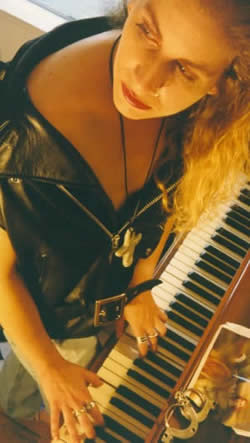 Image © Faith Strange Recordings 2003 |
I have never made much money from the work I do in the music business, because clubs don't pay and because I am an originals performer. For many years I cleaned houses for various kinds of people, from the very affluent to the elderly. I considered it very sacred work because it allowed me to get in touch with what is real. You can gain major fundamental insights when you are a servant to the public. It really was this purifying experience.
Film, my second intense focus, is quite symbiotic with music. I am an aficionado of several genres. I spend much of my time studying film. Most beloved is horror, and film noir. The horror film is a much-misunderstood genre. I am not talking about the commercial and gratuitous senseless blood bath and big tits teenage romp.
I am talking about the lost art of the horror film, the atmospheric gothic thrillers of the past such as Curtis Harringtonís 'horror of personality' films, or Mario Bavaís lush landscapes of terror, or Val Lewtonís poetic shadow plays in black in white.
I have been working on a series of essays about horror films. There is so much rich material to gather for music through the journey of film and films are driven by the energy that their music infuses it with. Iíd love to see my music utilized in soundtracks and ultimately I want to score more films, to marry the two mediums.
Please tell me what you think of your live performances and the audiences reaction to your on stage persona.
In most of my performances you can hear a pin drop. The people who experience me the first time have been so willing to embrace my music. I have had a lot of people approach me at the end of a show and ask why I am not signed to a big label. I usually can't answer that question, but it illustrates the point that there is a market for my music and people want to listen to it.
I think I have a pretty clearly defined unique persona. I am very real and very accessible. I am aware that I have moved my audience when I give myself away in my work. I love when Linda and I are together on stage. Piano and drums are an interesting configuration, it is very dynamic, melodic and primal. We are a very powerful duo.
It's like we have this telepathic synchronicity where we land on a dime together even when we spontaneously improvise. As far as doing another video, if the opportunity arose I would grab it. Passing Through Obscurity is actually a video that I could release if there were enough interest.
Where have you been hiding?
I chose to title the video Passing Through Obscurity for that very reason. It seems like I've been hiding, but the fact is the right people just weren't looking. Iíve just been on the periphery of the music scene. My music dwells on the periphery of the mainstream as well.
What are your plans for 2003?
Ideally, Linda and I would like to tour especially over in Europe. I am also busting to master my forthcoming albums The Amber Sessions and The Last Drive-In.I am in love with ethnic instrumentation and both these albums are infused with these world influences. I utilize sounds like the Tambor, Jun-Jun, Shruti Box and Indian Harmonium.
Drive-In is a very special project and I think one of my most favorite bodies of work. It is a homage to those themes from horror films and what they evoke in us. Drive-In strives to conjure those feelings again, not so much to tell a specific story, but to recreate what a shadow or an intense moment of mystery might feel like if it had a voice. With tracks like "Aren't You His Mother Rosemary," "There's a crack in the wall," "The House on the Hill" and "Sweet Charlotte."
Is there anything else in the works?
Linda and I want to do a full-length follow up to Tinderbox. We're thinking of using more of an under pulse of hypnotic and trippy grooves. Linda also has a very powerful voice and we will showcase that using her harmonies this time around. I have such a large archive of music to develop and I plan on going back to New York in the fall to hang with Linda and work on developing the new songs. Hopefully, We will be able to go to Luna County Observatory and lay some basic tracks.
I also have another shorter album in the laboratory titled A Fool's Day. I have already started developing the tracks "Ladders to Fire," "Quicksand" and "Certain Barbed Wire Fences." This is further down the road though. And I am trying to teach myself the accordion. I would love to learn how to play the cello and banjo. I can really visualize myself diddling by the edge of a cliff like Bud Cortís character in Harold and Maude.
How has the internet influenced your musical career and the promotion of your music?
I hope that it opens up a highway for people all over the world to get to know my music. The first album that I sold from the faithstrange.com website was purchased by someone in England. This kind of world exposure wasn't possible before for independent artists. I have much gratitude for Musical Discoveries taking an interest in my work and offering me a huge opportunity to express myself. The website does a great service to those of us who work so hard in the trenches who deserve the recognition and still pass through obscurity.
The internet is an incredible resource and I hope that I do manage to emerge a little more celebrated from this experience. I really want my music to go out and effect people. It has always been my desire to get the chance to unleash my songs into the universal consciousness and let those take from it what they will.
Thanks so much for letting me tell you a little bit about Jo Gabriel. I wish you peace.
Reviews (continued)
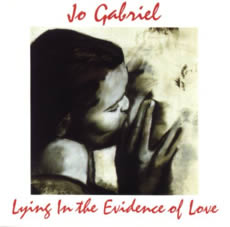 Lying In The Evidence Of Love Image © Falling Elevator Music (BMI) 1995 |
Lying In The Evidence Of Love. Jo Gabriel's debut album (Divine Inspiration Productions (USA) DIP 1438, 1996) is a timeless collection of fourteen tracks, dominated by heartfelt ballads. It is more vocals-orented than the two albums that followed it. Although at this writing, the original album is difficult to obtain, a repressing is being seriously considered and CD-Rs are being made on demand when the artist's current label (www.faithstrange.com) is contacted by those interested in obtaining a new one. It is a tremendous album that is certain to enthrall enthusiasts of Rachael Sage, Tori Amos and Kate Bush.
Lying in the Evidence of Love was voted one of the Nebula's Modern Musician Monthly's top indie pick of the month for the July, 1996 issue. The album has been described as "emotionally evocative, powerful and lyrically ethereal, throughout, Gabriel shows her talent as a vocalist totally in control of her instrument as well as an accomplished pianist."
Most of the album's tracks feature Jo's piano playing and many include further arrangements of guitar and keyboard. Percussion is crisp, never overpowering the other instruments or the vocals. Jo's voice dominates the album primarily in the lead role although she adds soft backing harmonies as well. The most pop-oriented tracks feature thicker instrumental arrangements that incorporate guitar and keyboard to excellent effect. Jo worked with John Leitch (guitars) and studio drummer Rich Pagano (drums) on the album and she met Linda Mackley (drums) who joined her band when they performed the material live. Robert Surace (keyboards) and Steve McCoy (percussion) also contributed to the sound.
The upbeat and lushly arranged "Scribble In The Sky" is certainly one of the album's standouts; "Love Is Love" an "Girl In The Attic" are equally superb. We especially enjoyed Jo's energetic piano playing, the added keyboard washes and guitar excursions that comprise the instrumental arrangements and compliment the sensual vocal delivery. A dynamic piano, guitar and percussion arrangement provides a memorable contrast to and excellent backdrop for Jo's vocals in another standout entitled "This."
The album also includes entirely stripped down pieces such as "Before You Leave" and "Fall Into You" that feature Jo's evocative vocals atop piano or acoustic guitar. At the far end of the extreme is the brief, entirely spoken version of "These Wings," which is immediately followed on the album by another short, but lovely piano dominated instrumental with the same title, accompanied by Jo's light and lovely vocalise. "Camouflage" is rockiest number of the album with electric guitar dominating in sharp contrast to the piano part in the arrangement.
Jo's voice works equally well atop acoustic and electric guitar in "Day In The Life," a track absent of piano but lush with keyboards and richly arranged backing vocals. "Prayer To You" continues in a similar vein, again without piano, but with lighter arrangements. Instrumentals in "My Freedom," yet another standout number, develop from light acoustic guitar to gentle rock adding electric guitar, keyboard washes and crisp percussion. "Somewhere You Were" and the stunning yet gentler number "Time" are similarly arranged.
In our most recent discussions with Jo about the album she remarked, "I still think
it has a lot of timelessly good material and many people are still listening to it today." The album's
tracks are vocally laced with Jo's tender and evocative delivery, even moreso than the releases
that follow. Yet Jo remarks, "I was working with a crew that really held sway over my creative
process." While she goes on to say that the album has some limitations, they won't be obvious
to most audiences. It is indeed a timeless album that is as appealing in 2004 as it was when
originally released in 1995. Lava's decision to proceed with Tori Amos as their female singer
songwriter instead of Jo Gabriel at the time must have been a very tough decision for the
label. 
Return to website contents